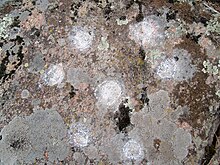Calendar stone from Leodagger
The calendar stone by Leodagger is a prehistoric cult site with a cup stone and a visor slit for observing the position of the sun. It is located in a field in the Weinviertel village of Leodagger ( municipality of Pulkau ) in Lower Austria .
Prehistoric cult place
The cult site consists of a rock formation with a sliding stone, several cup stones and a menhir . This rock protruding from flat terrain was a Bronze Age cult site, as archaeological excavations have shown. A smooth rock wall and a menhir form an approx. 50 cm wide visor gap through which the spring and autumn equinox can be observed. On top of the rock plateau is an extraordinary stone block with 16 pits, which were used as markings and possibly also for sun observation in prehistoric times. On a second stone 6 pans are arranged in a circle around a central bowl. They look astonishingly similar to the pattern of the Pleiades on the Nebra Sky Disc. Next to it, a larger and a smaller bowl has been rubbed into the stone. The entire rock formation is called "calendar stone", in the 14th century it was called "Stein im Aul" (Aul = Celtic from avos , German river ). Presumably it is an ancient spring and sun cult site.
Early Bronze Age sacrificial site
Schwammenhöfer succeeded in identifying the Leodagger calendar stone as an early Bronze Age cult and sacrificial complex. The ceramic finds that were discovered by the couple Schwammenhöfer and H. Puschnik in the visor gap when cleaning out the rock tub were of particular importance. At the rock tub in the center of the rock plateau there were two shards (wall fragment and piece of sediment), while a larger wall piece of a pot lay in the visor gap. All three shards are from the Bronze Age and are largely identical to the material from the Sonnwendberg near Leodagger. This find coincides with the results of rock art research in England, Scandinavia and, above all, in Italy, where cup stones of the present shape were dated to the Bronze Age (2000 to approx. 700 BC).
Possible use as a calendar
The 16 cells, up to about five centimeters in size, arranged in a line could indicate the 16-month solar year of the Stone Age . The natural scientist Alfred Kappl expresses this assumption in his book The Secret of the Feenhaube (see: Fehhaube-Kogelsteine Nature Reserve ). He interprets the pits of the stone as markings that were used to determine the positions of the sun and thus the calendar. With this archaic calendar system of 16 bowls, holidays could be set and sowing and harvest times in agriculture could be divided. The beginning of spring encouraged the cultivation of the fields, the beginning of autumn was the signal for stockpiling for the cold season. The bowls in the Pleiades pattern and the larger bowls next to them support the assumption that the cult site was used for astronomical purposes.
The rock formation is still used today to observe the equinoxes. The sun then appears exactly in the visor gap between the menhir and the rock face, according to today's date on March 21st and September 21st. If you want to take pictures of these bearings, you should get up early and position yourself on the specified date in the extension of the gap between the menhir and the calendar stone. The respective sunsets are also impressive. The calendar stone still works today with eternal precision.
literature
- Franz Jantsch : Cult places in the region around Vienna ; Freya publishing house, Unterweitersdorf 1993
- Herbert Puschnik : Eggenburg-Pulkau-Retz-Znaim prehistory hiking trail , Pulkau 1993
- Alfred Kappl: The secret of the fairy hood - The large stones of Eggenburg - Austria's Stonehenge , Sonnweg Verlag, 2001
- Hermann Schwammenhöfer: Archaeological educational trail (in Lower Austria), course scripts from the popular education centers
- Herta Puschnik: Studies on cup stones along the eastern edge of Manhartsberg in comparison to other European examples (PDF; 13.6 MB). "
Web links
Coordinates: 48 ° 43 '12 " N , 15 ° 51' 36.3" E

